1993 BUICK CENTURY ESP
[x] Cancel search: ESPPage 155 of 324

So here are some tips for passing:
“Drive ahead:’ Look down the road, to the sides, and
to crossroads for situations that might affect your
passing patterns. If you have any doubt whatsoever
about making a successful pass, wait for a better time.
Watch for traffic signs, pavement markings, and lines.
If you can
see a sign up ahead that might indicate a
turn or an intersection, delay your pass. A broken
center line usually indicates it’s
all right to pass
(providing the road ‘ahead is clear). Never cross a solid \
line on your side of the lane or a double solid line, even
if the road seems empty of approaching traffic.
If you suspect that the driver of the vehicle you want to
pass isn’t aware of your presence, tap the horn a couple
of times before passing.
Do not get too close to the vehicle you want to pass
while you’re awaiting
an opportunity. For one thing,
following too closely reduces your area
of vision,
especially if you’re following a larger vehicle. Also,
you won’t have adequate space if the vehicle ahead
suddenly slows or stops. Keep back a reasonable
distance.
When it looks like a chance to pass is coming up, start
to accelerate but stay in the right lane and don’t get too
close. Time your move
so you will be increasing speed
as the time comes to move into the other lane. If the
way is clear to pass,
you will have a “running start’’
that more than makes up for the distance you would
lose
by dropping back. And if something happens to
cause you to cancel your pass, you need only slow
down and drop back again and wait
for another
opportunity.
If other cars are lined up to pass a slow vehicle, wait
your turn. But take care that someone isn’t trying
to
pass you as you pull out to pass the slow vehicle.
Remember to glance over your shoulder and check the
blind spot.
start your left lane change signal before moving out of
the right lane to pass. When you are far enough ahead
of the passed vehicle to see its front
in your inside
mirror, activate your right lane change signal and move
back into
the right lane. (Remember that your right
outside mirror
is convex. The vehicle you just passed
may seem to be farther away from you
than it really is.)
Try not to pass more than one vehicle at a time on two-
lane roads. Reconsider before passing the next vehicle.
Check your mirrors, glance over your shoulder, and
ProCarManuals.com
Page 156 of 324
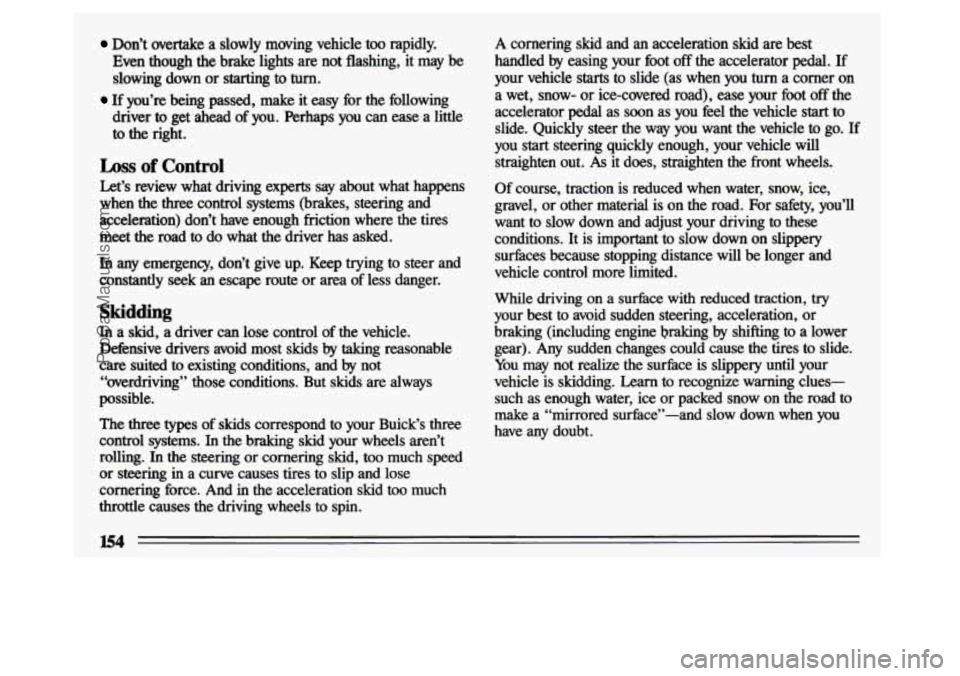
Don’t overtake a slowly moving vehicle too rapidly.
Even though the brake lights are not flashing, it
may be
slowing down or starting to turn.
driver to get ahead of you. Perhaps you can ease a little
to the right.
If you’re being passed, make it easy for the following
Loss of Control
Let’s review what driving experts say about what happens
when the three control systems (brakes, steering and
acceleration) don’t have enough friction where the tires
meet the road
to do what the driver has asked.
In any emergency, don’t give up. Keep trying to steer and
constantly
seek an escape route or area of less danger.
Skidding
In a skid, a driver can lose control of the vehicle.
Defensive drivers avoid most skids
by taking reasonable
care suited
to existing conditions, and by not
“overdriving” those conditions. But skids are always
possible.
The three types
of skids correspond to your Buick‘s three
control systems. In the braking skid your wheels aren’t
rolling.
In the steering or cornering skid, too much speed
or steering in a curve causes tires to slip and lose
cornering force. And
in the acceleration skid too much
throttle causes the driving wheels to spin.
I
A cornering skid and an acceleration skid are best
handled by easing your foot
off the accelerator pedal. If
your vehicle starts to slide (as when you turn a corner on
a wet, snow- or ice-covered road), ease your
foot off the
accelerator pedal as soon as you feel the vehicle start to
slide. Quickly steer the way you want the vehicle to go. If
you
start steering quickly enough, your vehicle will
straighten out. As it does, straighten the front wheels.
Of course, traction is reduced when water, snow, ice,
gravel, or other material is on the road.
For safety, you’ll
want to slow down and adjust your driving
to these
conditions. It is important to slow down on slippery
surfaces because stopping distance will be longer and
vehicle control more limited.
While driving on a surfhce
with reduced traction, try
your best to avoid sudden steering, acceleration, or
braking (including engine braking
by shifting to a lower
gear).
Any sudden changes could cause the tires to slide.
You may not realize the surface is slippery until your
vehicle is skidding.
Learn to recognize warning clues-
such as enough water, ice or packed snow on the road
to
make a “mirrored surface”-and slow down when you
have
any doubt.
154
ProCarManuals.com
Page 157 of 324

In a braking skid (where the wheels are no longer
rolling), release enough pressure on the brakes to get the
wheels rolling again.
This restores steering control. Push
the brake
pedal down steadily when you have to stop
suddenly.
As long as the wheels are rolling, you will have
steering control. Steer the way you want to go.
Driving at Night
Night driving is more dangerous than day driving. One
reason is that some drivers are likely to be impaired-by
alcohol or drugs, with night vision problems, or by fatigue.
Here are some tips on night driving.
Drive defensively. Remember, this is the most
dangerous time.
Don’t drink and drive. (See “Drunken Driving” in the
Index for more on this problem.)
Adjust your inside rearview mirror to reduce the glare
from headlights behind you.
Since you can’t see as well, you may need to slow
down and keep more space between you and other
vehicles. It’s hard to tell how fast the vehicle ahead is
going just by looking at its taillights.
Slow down, especially on higher speed roads. Your
headlights can light up only
so much road ahead.
In remote areas, watch for animals.
If you’re tired, pull off the road in a safe place and rest.
ProCarManuals.com
Page 160 of 324
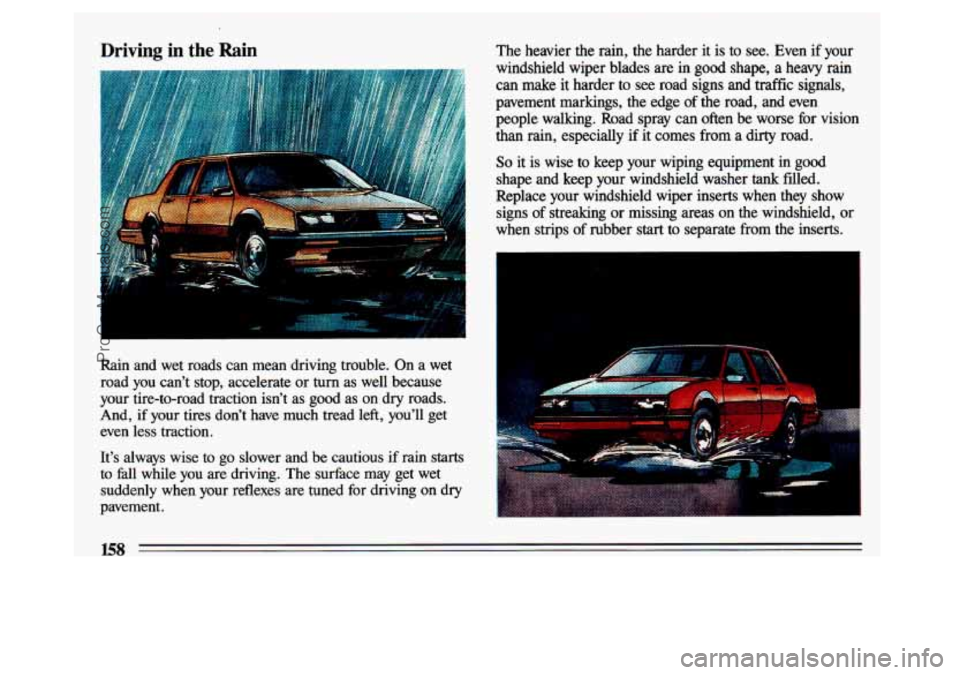
Driving in the Rain
Rain and wet roads can mean driving trouble. On a wet
road you can’t stop, accelerate or
turn as well because
your tire-to-road traction isn’t as good as on dry roads.
And, if your tires don’t have much tread left, you’ll ge\
t
even less traction.
It’s always wise to go slower and be cautious
if rain starts
to hll while you are driving. The surface may get wet
suddenly when your reflexes are tuned for driving on dry
pavement. The heavier the
rain, the harder it is to see. Even if your
windshield wiper blades are in
good shape, a heavy rain
can make
it harder to see road signs and traffic signals,
pavement markings, the edge of the road, and even
people walking. Road spray can often be worse for vision than rain, especially if it comes from a dirty road.
So it is wise to keep your wiping equipment in good
shape and keep your windshield washer
tank filled.
Replace your windshield wiper inserts when they show signs of streaking or missing areas on the windshield, or
when strips of rubber
start to separate from the inserts.
158
ProCarManuals.com
Page 162 of 324

Some Other Rainy Weather Tips
Turn on your headlights-not just your parking
lights-to help make you more visible to others.
-
Look for hard-to-see vehicles coming from behind. You
may want to use your headlights even in daytime if it’s
raining hard.
Besides slowing down, allow some extra following
distance. And be
especially careful when you pass
another vehicle.
Allow yourself more clear room
ahead, and be prepared to have your view restricted by
road
spray. If the road spray is so heavy you are actually
blinded, drop back. Don’t pass until conditions improve. Going more slowly is better than having an accident.
Use your defogger if it helps.
Have good tires with proper tread depth. (See “Tires”
in the Index.)
Driving in Fog, Mist and Haze
,. .,,
Fog can occur with high humidity or heavy frost. It can
be
so mild that you can see through it for severa1,hundred
feet (meters). Or it might be so thick that you can see
only a few
feet (meters) ahead. It may come suddenly to
an otherwise clear road. And it can be a major hazard.
When you drive into a fog patch, your visibility will be
reduced quickly. The biggest dangers
are striking the
vehicle ahead or being struck by the one behind’.
Try to
“read” the fog density down the road. If the vehicle
160
ProCarManuals.com
Page 163 of 324
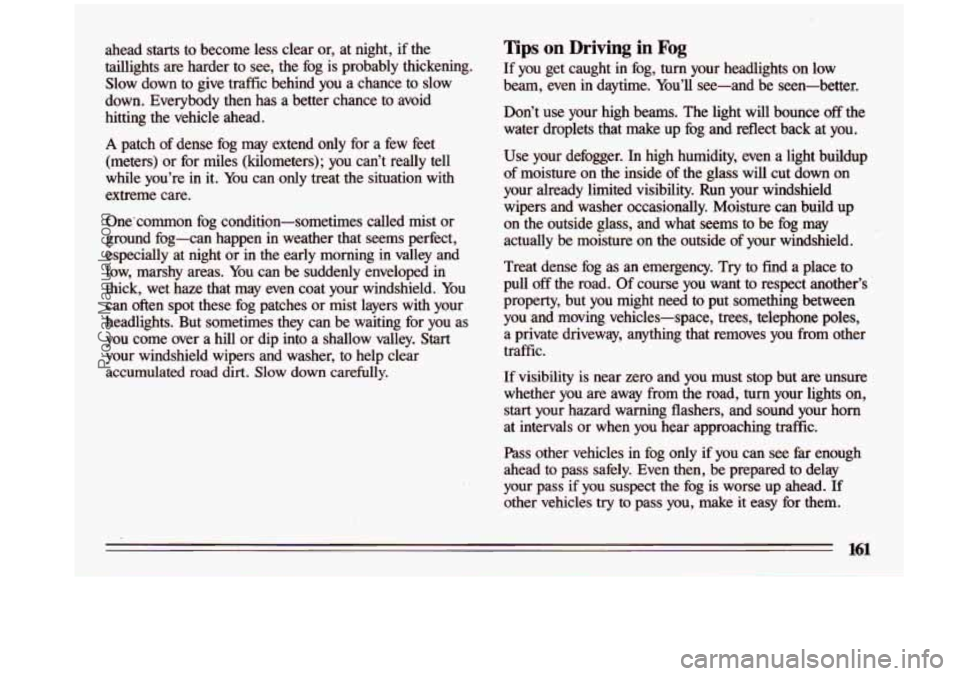
ahead starts to become less clear or, at night, if the
taillights are harder to see, the fog is probably thickening.
Slow down to give traffic behind you a chance to slow
down. Everybody then has a better chance to avoid hitting the vehicle ahead.
A patch of dense fog may extend only for a few feet
(meters) or for miles (kilometers); you can’t really tell
while you’re in it. You can only treat the situation with
extreme care.
One‘common fog condition-sometimes called mist or
ground fog-can happen in weather that seems perfect,
especially at night or
in the early morning in valley and
low, marshy areas. You can be suddenly enveloped in
thick, wet haze that may even coat your windshield. You
can often spot these fog patches or mist layers with your
headlights. But sometimes they can be waiting for you as
you come over a hill or dip into a shallow valley.
Start
your windshield wipers and washer, to help clear
accumulated
road dirt. Slow down carefully.
Tips on Driving in Fog
If you get caught in fog, turn your headlights on low
beam, even in daytime. You’ll see-and be seen-better.
Don’t use your high beams. The light will bounce
off the
water droplets that make up fog and reflect back at you.
Use your defogger. In high humidity, even a light buildup
of moisture on the inside of the glass will cut down on
your already limited visibility. Run your windshield
wipers and washer occasionally. Moisture can build up
on the outside glass, and what seems to be fog .may
actually be moisture on the outside
of your windshield.
Treat dense fog as an emergency.
Try to find a place to
pull off the road. Of course you want to respect another’s
property, but you might need to put something between
you and moving vehicles-space, trees, telephone poles,
a private driveway, anything that removes you from other
traffic.
If visibility is near zero and you must stop but
are unsure
whether you are away from the road, turn your lights on,
start your hazard warning flashers, and sound your horn
at intervals or when you hear approaching traffic.
Pass other vehicles in fog only if you can see far enough
ahead to pass safely. Even then, be prepared
to delay
your pass if you suspect the fog is worse up ahead.
If
other vehicles try to pass you, make it easy for them.
161
ProCarManuals.com
Page 164 of 324
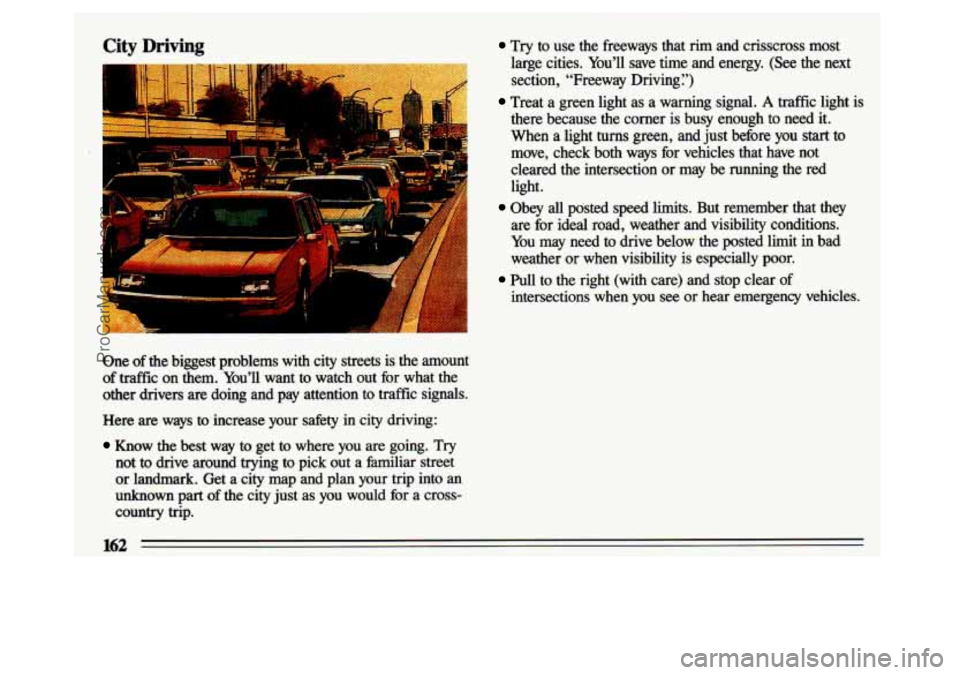
3ty
r--
i. _-- 4 ?I i
Try to use the freeways that rim and crisscross most
large cities. You’ll save time and energy. (See the next
section, “Freeway Driving?)
Treat a green light as a warning signal. A traffic light is
there because the corner is busy enough to need it.
When a light
turns green, and just before you start to
move, check both ways for vehicles that have not
cleared the intersection or may
be running the red
light.
Obey all posted speed limits. But remember that they are for ideal road, weather and visibility conditions.
You may need
to drive below the posted limit in bad
weather
or when visibility is especially poor.
Pull to the right (with care) and stop clear of
intersections when you see or hear emergency vehicles.
One of
the biggest problems with city streets is the amount
of traffic on them. You’ll want to watch out for what the
other drivers
are doing and pay attention to traffic signals.
Here
are ways to increase your safety in city driving:
Know the best way to get to where you are going. Try
not to drive around trying to pick out a familiar street
or landmark. Get a city map and plan your trip into an
unknown part of the city just as you would for a cross-
country trip.
162
ProCarManuals.com
Page 175 of 324
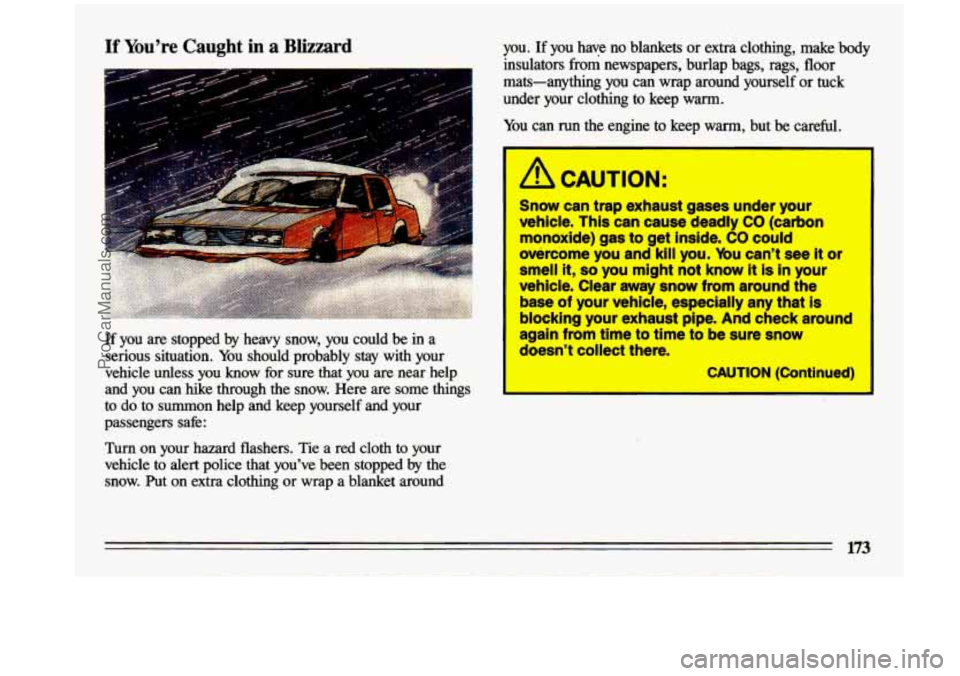
If You’re Caught in a Blizzard
J 1
If you are stopped by heavy snow, you could be in a
serious situation. You should probably stay with your
vehicle unless you
know for sure that you are near help
and you can hike through the snow. Here are some things
to do to summon help and keep yourself and your passengers safe:
Turn on your hazard flashers. Tie a red cloth to your
vehicle to alert police that you’ve been stopped by the
snow.
Put on extra clothing or wrap a blanket around
you. If you have no blankets or extra clothing, make body
insulators from newspapers, burlap bags, rags,
floor
mats-anything you can wrap around yourself or tuck
under your clothing
to keep warm.
You can run the engine to keep
warm, but be careful.
I-
I A CAUTION:
Snow can trap exhaust gases under your
vehicle. This can cause deadly
CO (carbon
monoxide) gas
to get inside. CO could
overcome you and kill you. You can’t see
it or
smell it, so you might not know it is in your
vehicle. Clear away snow from around the
base
of your vehicle, especially any that is
blocking your exhaust pipe.
And check around
again from time to time to be sure snow
doesn’t collect there.
I CAUTION (Continued)
173
ProCarManuals.com